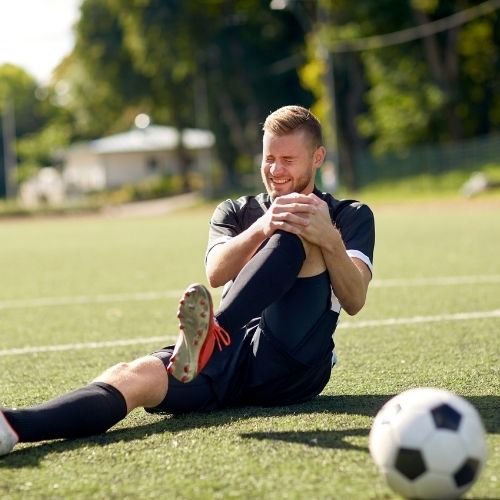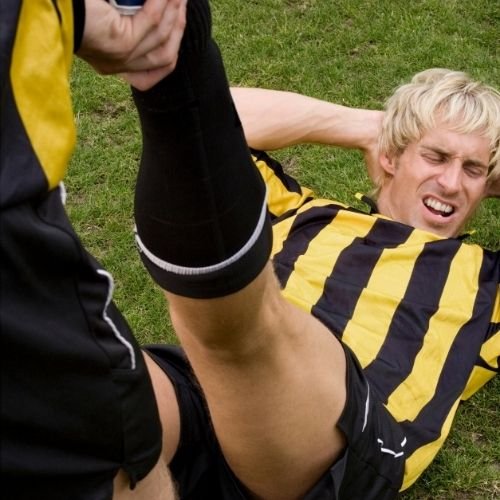Physio for Common Football Injuries
According to the global sports data company, STATS, footballers run for around seven miles during each game they play. This, alongside tackles and falls, greatly increases the risk of injury.
Unsurprisingly, the majority of football injuries occur in the knees and legs. Here, we will address some common football injuries players are susceptible to, and the treatment players require for each one.
What are common football injuries?
1. Ankle sprains
Ankle sprains are a common football injury involving soft tissue damage around the ankle (mainly ligaments). They typically occur when the ankle twists inwards, and damage to the capsule may also occur. If the capsule is damaged alongside the ligaments, it can lead to bleeding within the tissue, causing painful swelling to develop.
Players who suffer ankle sprains should follow the ‘RICE’ protocol (rest, ice, compression, and elevation) immediately after the injury has occurred. After this, rehabilitation with a Foot & Ankle specialist can help regain ankle function.
2. Hamstring Strain
Hamstring strains make up around 40% of injuries in Premiership football. They tend to occur due to sprinting, when the muscles are stretched beyond their capabilities. This causes a tear, which can be classified as a first, second, or third degree tear. Other predisposing factors include muscle imbalances or tightness, poor flexibility and strength, overtraining and leg length differences.
Like an ankle sprain, the first step to treating a hamstring strain is RICE. Early on, after this, the injury will need to be assessed by a physiotherapist, to grade the degree of the injury and to individualise the rehab/exercise plan.
When treated early by a physio, a player with a Grade 1 strain can expect to return to sport after three weeks. For Grade 2 strains, your rehab should get you back to sport after 4-6 weeks.
3. Knee Cartilage Tear
An analysis of injuries (PhysioRoom, 2004/2005), revealed that around 12% of Premiership injuries involved a torn cartilage. This common injury typically impacts the meniscus of the knee, causing it to become swollen and painful. This type of injury tends to occur when the joint is bearing weight as it twists and rotates. If there is a lot of force applied, it causes a tear in the meniscus.
Players who suffer a knee cartilage tear often have biomechanical issues or a history of injury of the knee. Often meniscus tears do not heal by themselves, requiring the meniscus to be either trimmed or treated with an arthroscopy (keyhole surgery), especially if rotation is an important part of your activity. Physiotherapy is required for a period of 4 to 6 weeks to help build up the strength, full range of movement, and mobility in the joint.
4. ACL Injury
Located in the knee joint, the Anterior Cruciate Ligament (ACL) connects the shin and the thigh bone. It helps to prevent excess rotation of the knee, as well as prevent the shin from moving too far forward from the thigh. It plays a big role in balance and control of knee movement as well. Footballers can injure their ACL when the foot is planted and the body suddenly changes direction, typically a twisting inwards motion away from the knee. It is likely the knee will swell significantly.
ACL injury can be diagnosed quickly following injury. To return to football, it is likely that surgery will be required to reconstruct the ligament once post-injury swelling has settled to manage the forces the knee experiences during a game. If surgery is required, an orthopaedic surgeon works alongside your physiotherapist through a structured rehabilitation programme to prevent re-injury.
Physio for Sports Injury Prevention
Physiotherapy is typically the best form of treatment for most football injuries, and can help to reduce the need for surgery in mild to moderate injuries. Additionally though, physio is a great preventative measure for injury. Especially the recurrence of knee injury, as well as the recovery from it. In fact, there is emerging evidence that load management programs can help mitigate injury risk among soccer players.
By working with a specialist sports injury physio to strengthen the muscles around the knees and lower limbs, correcting any muscle imbalances, you can improve your speed and coordination, as well as lower the risk of injury.
Get in touch with us to find out about our clinical strength and conditioning service, whether you have sustained an injury in football or not. Reduce the risk of a knee injury and take your football to the next level.




